Your baby’s head is one of their most fragile parts when they are born.
Unlike those little elbow and knee joints, their skull is yet to be properly set making it soft and pliable.

This means that the shape of their heads can be changed, even with the most gentleness of pressures. If your little one always rests in the same position, flattening of the head may become noticeable.
The best way to stop flattening is to make sure your baby gets lots of tummy time when they are awake. Most flattening will correct itself but if you’re concerned about flat head syndrome, we’ve got all the info here.
There are two types of this condition,
Plagiocephaly – flattening on one side of a baby’s head as a result of continued pressure on that spot. In the most severe cases this condition could contribute to jaw and dental problems later on in your child’s life.
Brachycephaly – This happens when babies lie for long periods on their backs. This causes the back of their little head to become flat resulting in a disproportionately wide head compared to the depth.
Why does flat head syndrome happen?
Since experts found that babies sleep more safely on their backs – laying them in this position is known to reduce the risk of Sudden Infant Death Syndrome – flat head syndrome is said to have increased. Perhaps this is why babies spend much of their little lives sleeping or laying on their backs, being in a car seat or lying in your arms. And this puts pressure on the back of their heads.
Other factors could include,
Pregnancy and labour – some believe the condition can be caused because of a lack of amniotic fluid and your little one’s journey through the birth canal.
Premature birth – Premature babies are also said to be prone to Flat Head Syndrome because their skulls are softer than full term babies.
A medical problem – Craniosynotosis is when the bony plates of a baby's skull join together too early resulting in your baby’s head being pulled out of shape. This will have to be corrected through surgery.
Flat head syndrome can be caused by tight neck muscles that make it hard for babies to turn their heads. This neck condition is called Torticollis and sometimes a physio referral will be made to help with strengthening the twisted neck muscles or you will be given exercises to try at home with your baby.
How do I help my baby if they have flat head syndrome?
The first thing to do if you should do if you believe your little one has this condition is speak to your health visitor or doctor.
They may advise the following,
Changing your baby’s position during the day to relieve some of the pressure from the flattened area. This includes lots of tummy time.
Tummy time means giving your little one a few minutes a day on their tummies on a mat on the floor. Start with just a couple of minutes and work up over the next few weeks and months to 15-30 minutes. If they don’t like it at first, try getting down there with them and holding your head level with theirs.
They won’t be able to hold their head up for long in the early days and you may have to rescue them occasionally, but it’s a great exercise for the muscles they’ll later need for turning over and crawling.
You’ll soon notice that they are also trying to push up with their arms as they look around.
Changing the position of toys and mobiles in their cot to encourage your baby to turn their head to the non-flattened side. If your baby has difficulty turning their head, physiotherapy may help loosen and strengthen their neck muscles.
Headband or helmet therapy
Helmets or headbands, known as cranial orthoses, are said to improve the symmetry of a baby's skull.
They are custom-made and work by applying pressure to "bulging" parts of the skull and relieving pressure from other parts, allowing growth in the flatter areas.
These are designed to be used when a baby’s skull is still soft and malleable and are said to be the most effective between the ages of four and 12 months.
However, the use of helmets and headbands is unclear, and as such they're not available on the NHS yet and treatment can cost around £2,500.